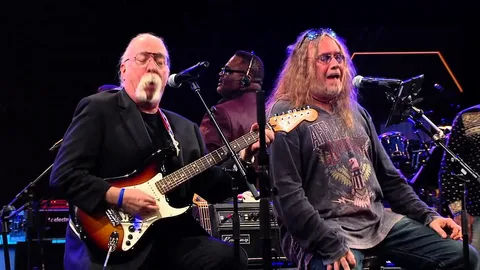
Most fans of the Doobie Brothers seem to have allegiances to particular periods in the band’s 45-year history — with the most common divide being Tom Johnston vs. Michael McDonald.
I love the classic-rock era from 1969-74 and was happy to see a version of that band reform in 1987, but the current version seems to be missing a rhythmic and sonic landscape that was developed while Jeff “Skunk” Baxter was in the Doobie Brothers from 1975-79. Many call these the McDonald years, but I’ll argue that Baxter’s influence was just as significant.
Baxter exited Steely Dan in 1974 and slid over to the Doobies for the Stampede album, providing a sophisticated yet fiery guitar and cunning pedal steel guitar work. In 1975, when the Doobies needed a singer, it was Baxter who called on McDonald to fill the shoes of Tom Johnston.
Here are five tracks that trace Jeff “Skunk” Baxter’s often-overlooked impact on the Doobie Brothers …
NEAL’S FANDANDO,” (STAMPEDE, 1975): This is Baxter’s first album as a full-fledged Doobie, though he appears on the prior two releases. Pat Simmons’ homage to a mentor, “Neal’s Fandango” is a full-throttled stew of county rock propelled by dueling lead guitars from Simmons and Tom Johnston — with an amazing pedal steel part by then newcomer Baxter, too boot. The song also features some of the best double drumming on a Doobies track. (Honorable mention goes to the single “Take Me In Your Arms (Rock Me A Little While),” where Baxter plays the solo.
LIVIN’ ON THE FAULT LINE,” (LIVIN’ ON THE FAULT LINE, 1977): Written by Patrick Simmons, who has on occasion come up with genre-bending songs like “Daughters of The Sea” and “I Cheat The Hangman,” but had never before stepped so boldly into jazz-rock as he did here. This title track is supported by an outstanding drumming from Keith Knudsen, and a bass track from Tiran Porter that would make Chuck Rainey jealous. McDonald proves his meddle as an instrumentalist with synth and Fender Rhodes parts, while the late Victor Feldman provides a guest turn on the vibraphone worthy of a Steely Dan album. Jeff Baxter and Patrick Simmons trade electric guitar parts which are wonderfully constructed. This is one of the best treasures of the Doobie Brothers and also very un-Doobie like. (Honorable mention goes to the song “Chinatown,” which is another Simmons epic this time capped with a psychedelic Roland guitar synthesizer solo from Baxter.)
RIO,” (TAKIN IT TO THE STREETS, 1976): The lead-off track to Side Two, co-written by Patrick Simmons and Jeff Baxter, shows a new sophistication. Perhaps one of the most complex arrangements by the band to date, “Rio” effectively uses McDonald’s Fender Rhodes piano, Bobby LaKind’s congas and amazing lead guitar from Baxter. (Honorable mention goes to the opening track “Wheels of Fortune,” which was co-written by Baxter and contains amazing guitar work from Skunk and Simmons in addition to a cameo by Little Feat drummer Richie Hayward.)
YOU’RE MADE THAT WAY,” (LIVIN’ ON THE FAULT LINE, 1977): Co-written by Baxter with McDonald and drummer Keith Knudsen, the track finds the band in full R&B mode. Knudsen proves incredibly versatile on “You’re Made That Way,” with a gorgeous drum foundation, while Baxter provides a laid back Larry Carlton-like guitar as well as an all too brief solo. The song is further augmented by a stirring string arrangement from future Toto keyboardist, David Paich. (Honorable mention “Echoes of Love,” a pop ditty with the effective rhythm synth/guitar solo.)
HOW DO THE FOOLS SURVIVE,” (MINUTE BY MINUTE, 1978): The last song on the last album that Jeff “Skunk” Baxter appeared on with the Doobie Brothers. Minute By Minute would become the group’s most commercially successful album, but also the most constrained with regard to arrangements. Here is one of the few times Jeff Baxter got to stretch. In fact, Patrick Simmons’ guitar is inaudible through the track, while Baxter provides a fitting climax to his tenure with the band with his solo on the tag. (Honorable mention “You Never Change,” a Simmons-composed tune with an elegant rhythm and solo guitar part which incorporates Jeff Baxter’s Roland synth guitar and Simmons’ Gibson 335.
© Copyrights 2025 Preston M. Frazier. All Rights Reserved